Material Selection Report: Analysis of Engineering Materials
VerifiedAdded on 2023/01/18
|7
|1923
|93
Report
AI Summary
This report details the material selection process for several engineering applications, including car dashboards, aircraft fuselage rivets, window latches for a beach house, fuel tanks for hydrogen-powered cars, and pressure vessels for caustic soda. The report identifies desired material properties for each application, such as lightweight, strength, corrosion resistance, and thermal properties. It then evaluates candidate materials like ABS, wood, aluminum alloys, stainless steel, and fiberglass, comparing their properties based on density, cost, yield strength, fracture toughness, and service temperature. The selection process involves ruling out materials based on cost, weight, and performance criteria, ultimately justifying the choice of the most suitable material for each specific application, supported by references to relevant literature.
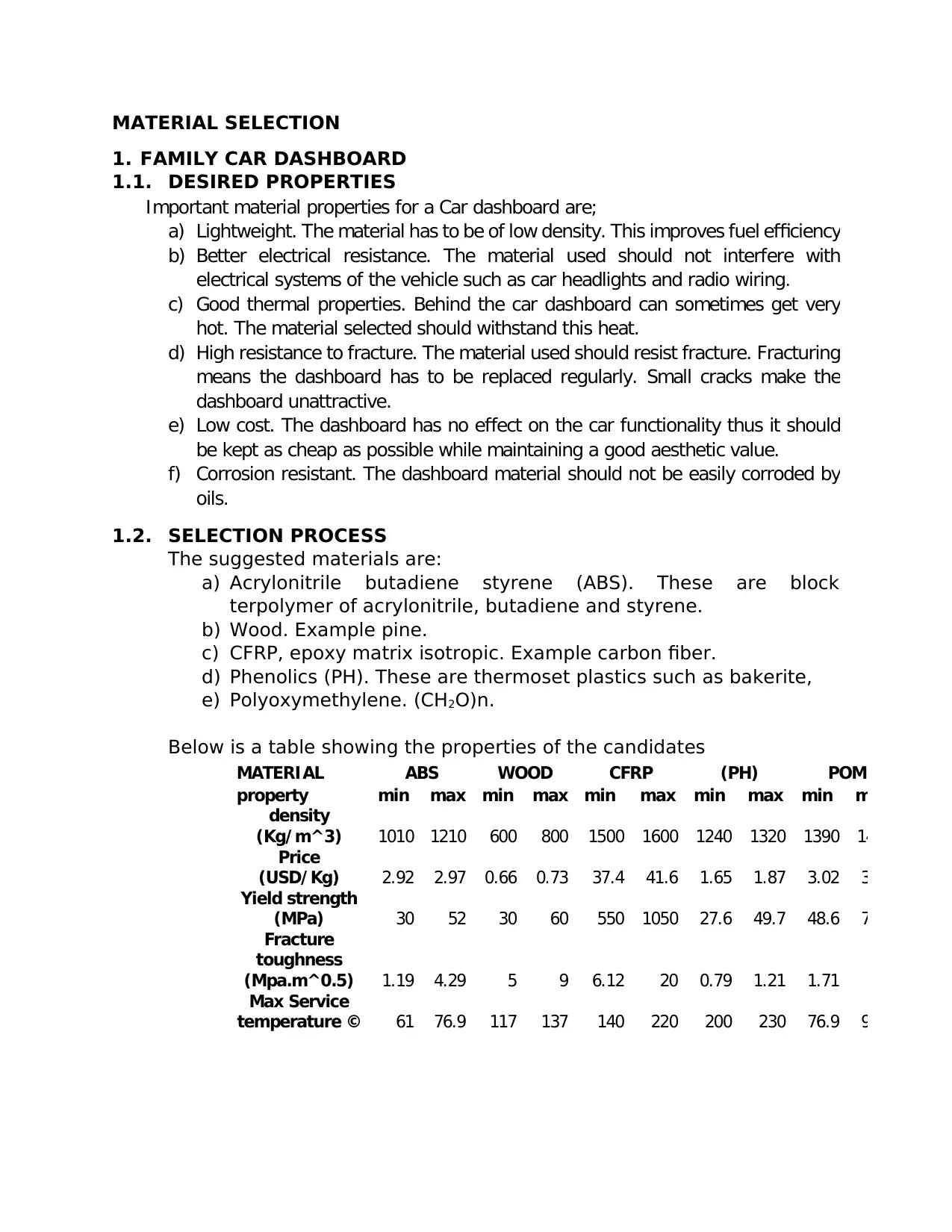
MATERIAL SELECTION
1. FAMILY CAR DASHBOARD
1.1. DESIRED PROPERTIES
Important material properties for a Car dashboard are;
a) Lightweight. The material has to be of low density. This improves fuel efficiency
b) Better electrical resistance. The material used should not interfere with
electrical systems of the vehicle such as car headlights and radio wiring.
c) Good thermal properties. Behind the car dashboard can sometimes get very
hot. The material selected should withstand this heat.
d) High resistance to fracture. The material used should resist fracture. Fracturing
means the dashboard has to be replaced regularly. Small cracks make the
dashboard unattractive.
e) Low cost. The dashboard has no effect on the car functionality thus it should
be kept as cheap as possible while maintaining a good aesthetic value.
f) Corrosion resistant. The dashboard material should not be easily corroded by
oils.
1.2. SELECTION PROCESS
The suggested materials are:
a) Acrylonitrile butadiene styrene (ABS). These are block
terpolymer of acrylonitrile, butadiene and styrene.
b) Wood. Example pine.
c) CFRP, epoxy matrix isotropic. Example carbon fiber.
d) Phenolics (PH). These are thermoset plastics such as bakerite,
e) Polyoxymethylene. (CH2O)n.
Below is a table showing the properties of the candidates
MATERI AL ABS WOOD CFRP (PH) POM
property min max min max min max min max min max
density
(Kg/ m^3) 1010 1210 600 800 1500 1600 1240 1320 1390 1430
Price
(USD/ Kg) 2.92 2.97 0.66 0.73 37.4 41.6 1.65 1.87 3.02 3.17
Yield strength
(MPa) 30 52 30 60 550 1050 27.6 49.7 48.6 72.4
Fracture
toughness
(Mpa.m^0.5) 1.19 4.29 5 9 6.12 20 0.79 1.21 1.71 4.2
Max Service
temperature © 61 76.9 117 137 140 220 200 230 76.9 96.9
1. FAMILY CAR DASHBOARD
1.1. DESIRED PROPERTIES
Important material properties for a Car dashboard are;
a) Lightweight. The material has to be of low density. This improves fuel efficiency
b) Better electrical resistance. The material used should not interfere with
electrical systems of the vehicle such as car headlights and radio wiring.
c) Good thermal properties. Behind the car dashboard can sometimes get very
hot. The material selected should withstand this heat.
d) High resistance to fracture. The material used should resist fracture. Fracturing
means the dashboard has to be replaced regularly. Small cracks make the
dashboard unattractive.
e) Low cost. The dashboard has no effect on the car functionality thus it should
be kept as cheap as possible while maintaining a good aesthetic value.
f) Corrosion resistant. The dashboard material should not be easily corroded by
oils.
1.2. SELECTION PROCESS
The suggested materials are:
a) Acrylonitrile butadiene styrene (ABS). These are block
terpolymer of acrylonitrile, butadiene and styrene.
b) Wood. Example pine.
c) CFRP, epoxy matrix isotropic. Example carbon fiber.
d) Phenolics (PH). These are thermoset plastics such as bakerite,
e) Polyoxymethylene. (CH2O)n.
Below is a table showing the properties of the candidates
MATERI AL ABS WOOD CFRP (PH) POM
property min max min max min max min max min max
density
(Kg/ m^3) 1010 1210 600 800 1500 1600 1240 1320 1390 1430
Price
(USD/ Kg) 2.92 2.97 0.66 0.73 37.4 41.6 1.65 1.87 3.02 3.17
Yield strength
(MPa) 30 52 30 60 550 1050 27.6 49.7 48.6 72.4
Fracture
toughness
(Mpa.m^0.5) 1.19 4.29 5 9 6.12 20 0.79 1.21 1.71 4.2
Max Service
temperature © 61 76.9 117 137 140 220 200 230 76.9 96.9
Paraphrase This Document
Need a fresh take? Get an instant paraphrase of this document with our AI Paraphraser

First, we rule out CFRP due to its high cost per kilogram. For sports cars, CFRP is
very appealing and has the best aesthetic value. Next, we consider weight.
Phenolics and Polyoxymethylene materials are denser than ABS and wood hence
they are ruled out. The best materials are wood and ABS. Though initial cost of
wood is low, it would be expensive since special cutting and treatment have to be
done on the wood to make it usable in dashboards.
(Remin 2019)
Sometimes wood is used
together with ABS. ABS
plastics are cheap, and
lighter than carbon
composites. These plastics
are easy to mold and can be
shaped to any shape. ABS
plastics are very common
(Yangzhou Chengsen, 2019)
2. 747-800 FUSELAGE RIVETS
2.1. DESIRED PROPERTIES
Important material properties for a Car dashboard are;
a) Strength. The rivets used in fuselage should be strong against
yielding.
b) Non corrosive. The rivets should not be corroded by water and other
substances such as oil.
c) Good thermal properties. Some applications require heat resistant
materials.
2.2. SELECTION PROCESS
Below are the candidates for 747-800 fuselage rivets.
very appealing and has the best aesthetic value. Next, we consider weight.
Phenolics and Polyoxymethylene materials are denser than ABS and wood hence
they are ruled out. The best materials are wood and ABS. Though initial cost of
wood is low, it would be expensive since special cutting and treatment have to be
done on the wood to make it usable in dashboards.
(Remin 2019)
Sometimes wood is used
together with ABS. ABS
plastics are cheap, and
lighter than carbon
composites. These plastics
are easy to mold and can be
shaped to any shape. ABS
plastics are very common
(Yangzhou Chengsen, 2019)
2. 747-800 FUSELAGE RIVETS
2.1. DESIRED PROPERTIES
Important material properties for a Car dashboard are;
a) Strength. The rivets used in fuselage should be strong against
yielding.
b) Non corrosive. The rivets should not be corroded by water and other
substances such as oil.
c) Good thermal properties. Some applications require heat resistant
materials.
2.2. SELECTION PROCESS
Below are the candidates for 747-800 fuselage rivets.
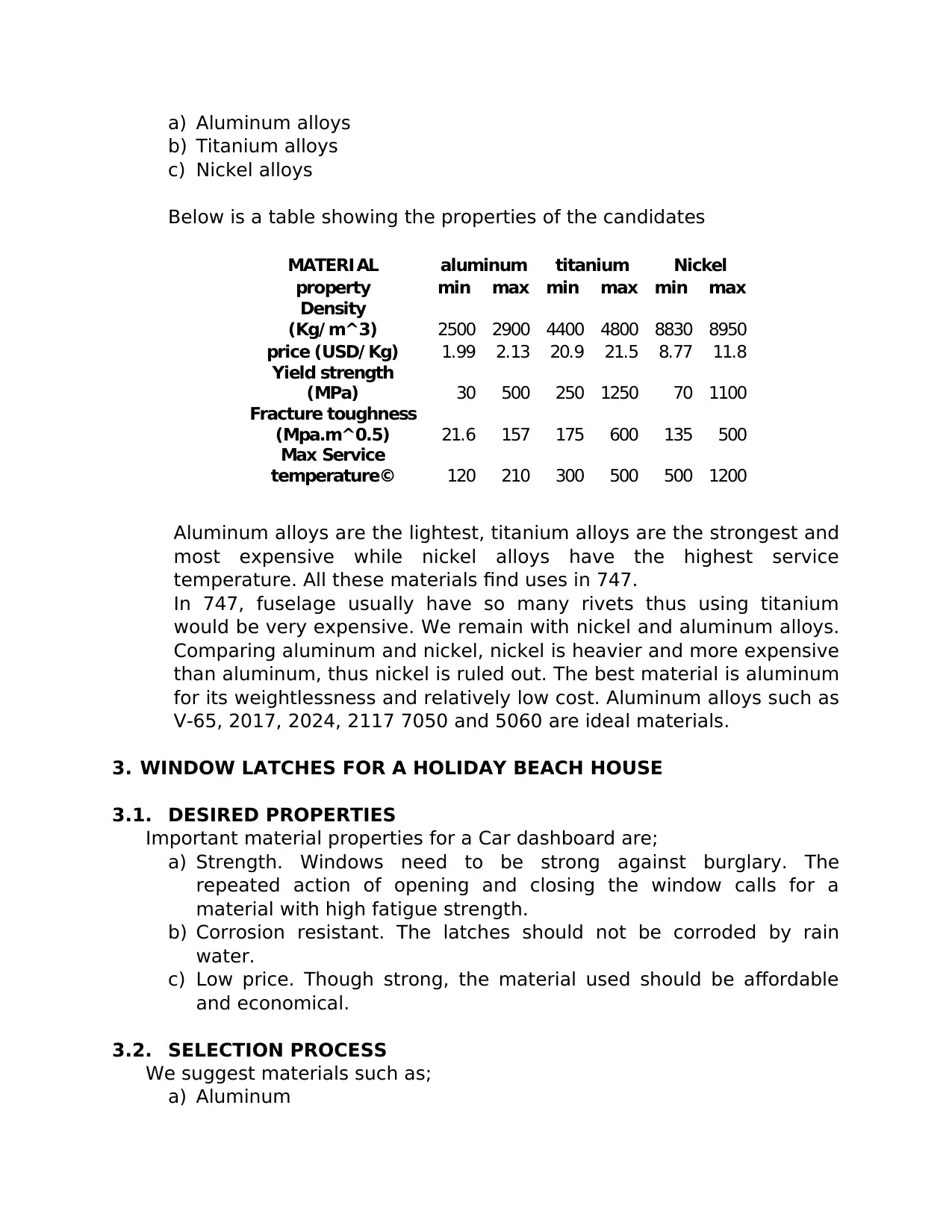
a) Aluminum alloys
b) Titanium alloys
c) Nickel alloys
Below is a table showing the properties of the candidates
MATERI AL aluminum titanium Nickel
property min max min max min max
Density
(Kg/ m^3) 2500 2900 4400 4800 8830 8950
price (USD/ Kg) 1.99 2.13 20.9 21.5 8.77 11.8
Yield strength
(MPa) 30 500 250 1250 70 1100
Fracture toughness
(Mpa.m^0.5) 21.6 157 175 600 135 500
Max Service
temperature© 120 210 300 500 500 1200
Aluminum alloys are the lightest, titanium alloys are the strongest and
most expensive while nickel alloys have the highest service
temperature. All these materials find uses in 747.
In 747, fuselage usually have so many rivets thus using titanium
would be very expensive. We remain with nickel and aluminum alloys.
Comparing aluminum and nickel, nickel is heavier and more expensive
than aluminum, thus nickel is ruled out. The best material is aluminum
for its weightlessness and relatively low cost. Aluminum alloys such as
V-65, 2017, 2024, 2117 7050 and 5060 are ideal materials.
3. WINDOW LATCHES FOR A HOLIDAY BEACH HOUSE
3.1. DESIRED PROPERTIES
Important material properties for a Car dashboard are;
a) Strength. Windows need to be strong against burglary. The
repeated action of opening and closing the window calls for a
material with high fatigue strength.
b) Corrosion resistant. The latches should not be corroded by rain
water.
c) Low price. Though strong, the material used should be affordable
and economical.
3.2. SELECTION PROCESS
We suggest materials such as;
a) Aluminum
b) Titanium alloys
c) Nickel alloys
Below is a table showing the properties of the candidates
MATERI AL aluminum titanium Nickel
property min max min max min max
Density
(Kg/ m^3) 2500 2900 4400 4800 8830 8950
price (USD/ Kg) 1.99 2.13 20.9 21.5 8.77 11.8
Yield strength
(MPa) 30 500 250 1250 70 1100
Fracture toughness
(Mpa.m^0.5) 21.6 157 175 600 135 500
Max Service
temperature© 120 210 300 500 500 1200
Aluminum alloys are the lightest, titanium alloys are the strongest and
most expensive while nickel alloys have the highest service
temperature. All these materials find uses in 747.
In 747, fuselage usually have so many rivets thus using titanium
would be very expensive. We remain with nickel and aluminum alloys.
Comparing aluminum and nickel, nickel is heavier and more expensive
than aluminum, thus nickel is ruled out. The best material is aluminum
for its weightlessness and relatively low cost. Aluminum alloys such as
V-65, 2017, 2024, 2117 7050 and 5060 are ideal materials.
3. WINDOW LATCHES FOR A HOLIDAY BEACH HOUSE
3.1. DESIRED PROPERTIES
Important material properties for a Car dashboard are;
a) Strength. Windows need to be strong against burglary. The
repeated action of opening and closing the window calls for a
material with high fatigue strength.
b) Corrosion resistant. The latches should not be corroded by rain
water.
c) Low price. Though strong, the material used should be affordable
and economical.
3.2. SELECTION PROCESS
We suggest materials such as;
a) Aluminum
⊘ This is a preview!⊘
Do you want full access?
Subscribe today to unlock all pages.

Trusted by 1+ million students worldwide
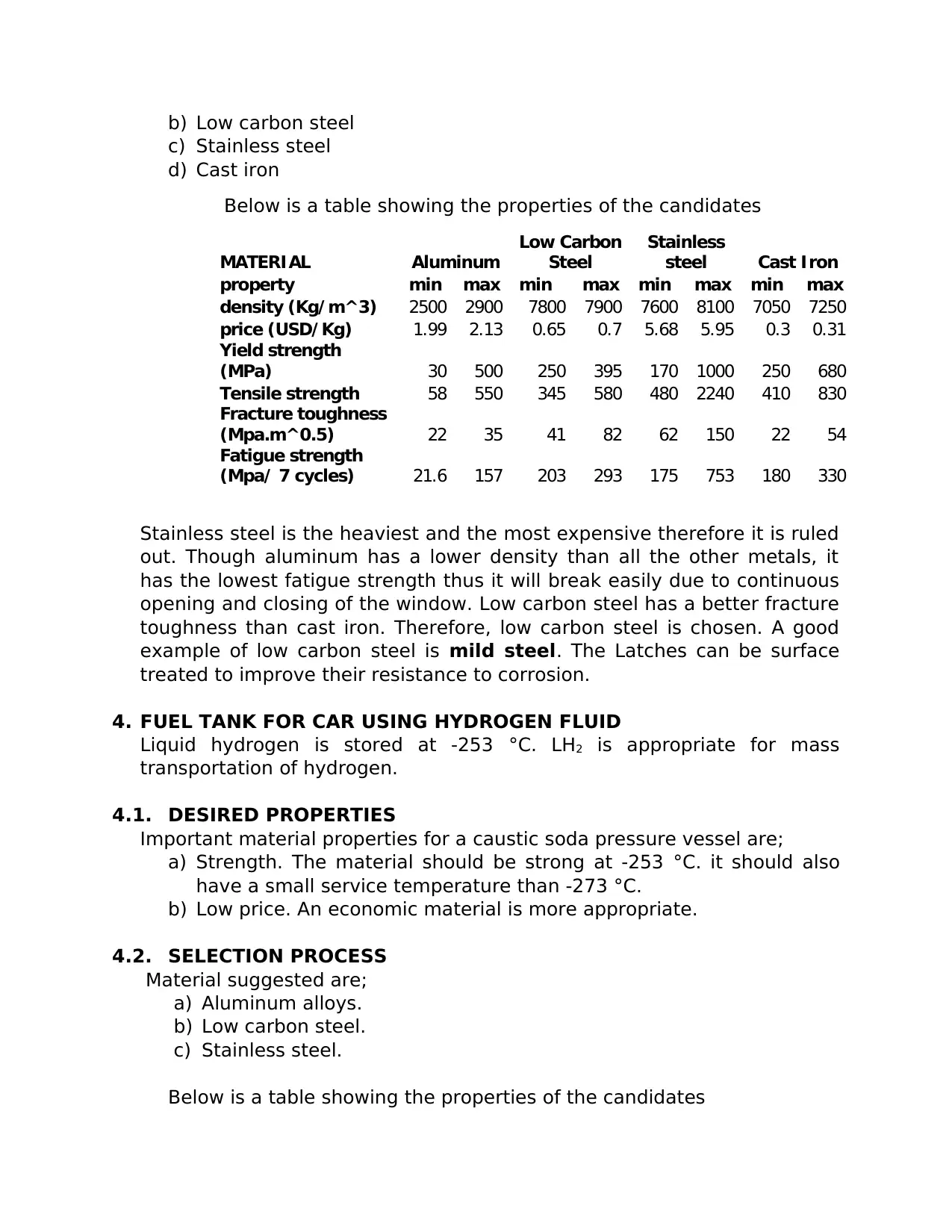
b) Low carbon steel
c) Stainless steel
d) Cast iron
Below is a table showing the properties of the candidates
MATERI AL Aluminum
Low Carbon
Steel
Stainless
steel Cast Iron
property min max min max min max min max
density (Kg/ m^3) 2500 2900 7800 7900 7600 8100 7050 7250
price (USD/ Kg) 1.99 2.13 0.65 0.7 5.68 5.95 0.3 0.31
Yield strength
(MPa) 30 500 250 395 170 1000 250 680
Tensile strength 58 550 345 580 480 2240 410 830
Fracture toughness
(Mpa.m^0.5) 22 35 41 82 62 150 22 54
Fatigue strength
(Mpa/ 7 cycles) 21.6 157 203 293 175 753 180 330
Stainless steel is the heaviest and the most expensive therefore it is ruled
out. Though aluminum has a lower density than all the other metals, it
has the lowest fatigue strength thus it will break easily due to continuous
opening and closing of the window. Low carbon steel has a better fracture
toughness than cast iron. Therefore, low carbon steel is chosen. A good
example of low carbon steel is mild steel. The Latches can be surface
treated to improve their resistance to corrosion.
4. FUEL TANK FOR CAR USING HYDROGEN FLUID
Liquid hydrogen is stored at -253 °C. LH2 is appropriate for mass
transportation of hydrogen.
4.1. DESIRED PROPERTIES
Important material properties for a caustic soda pressure vessel are;
a) Strength. The material should be strong at -253 °C. it should also
have a small service temperature than -273 °C.
b) Low price. An economic material is more appropriate.
4.2. SELECTION PROCESS
Material suggested are;
a) Aluminum alloys.
b) Low carbon steel.
c) Stainless steel.
Below is a table showing the properties of the candidates
c) Stainless steel
d) Cast iron
Below is a table showing the properties of the candidates
MATERI AL Aluminum
Low Carbon
Steel
Stainless
steel Cast Iron
property min max min max min max min max
density (Kg/ m^3) 2500 2900 7800 7900 7600 8100 7050 7250
price (USD/ Kg) 1.99 2.13 0.65 0.7 5.68 5.95 0.3 0.31
Yield strength
(MPa) 30 500 250 395 170 1000 250 680
Tensile strength 58 550 345 580 480 2240 410 830
Fracture toughness
(Mpa.m^0.5) 22 35 41 82 62 150 22 54
Fatigue strength
(Mpa/ 7 cycles) 21.6 157 203 293 175 753 180 330
Stainless steel is the heaviest and the most expensive therefore it is ruled
out. Though aluminum has a lower density than all the other metals, it
has the lowest fatigue strength thus it will break easily due to continuous
opening and closing of the window. Low carbon steel has a better fracture
toughness than cast iron. Therefore, low carbon steel is chosen. A good
example of low carbon steel is mild steel. The Latches can be surface
treated to improve their resistance to corrosion.
4. FUEL TANK FOR CAR USING HYDROGEN FLUID
Liquid hydrogen is stored at -253 °C. LH2 is appropriate for mass
transportation of hydrogen.
4.1. DESIRED PROPERTIES
Important material properties for a caustic soda pressure vessel are;
a) Strength. The material should be strong at -253 °C. it should also
have a small service temperature than -273 °C.
b) Low price. An economic material is more appropriate.
4.2. SELECTION PROCESS
Material suggested are;
a) Aluminum alloys.
b) Low carbon steel.
c) Stainless steel.
Below is a table showing the properties of the candidates
Paraphrase This Document
Need a fresh take? Get an instant paraphrase of this document with our AI Paraphraser

MATERIAL
Aluminum
Low Carbon
Steel
Stainless
steel
property min max min max min max
density (Kg/ m^3) 2500 2900 7800 7900 7600 8100
price (USD/ Kg) 1.99 2.13 0.65 0.7 5.68 5.95
Yield strength (MPa) 30 500 250 395 170 1000
Tensile strength 58 550 345 580 480 2240
Fracture toughness
(Mpa.m^0.5) 22 35 41 82 62 150
Fatigue strength (Mpa/ 7
cycles) 21.6 157 203 293 175 753
Minimum service temperature -273 -68 -38.2 -272 271
Steel has a minimum service temperature of between -68 °C to -38.2 °C.
At -200 °C, steel is usually very weak. Therefore, we rule out low carbon
steels.
The minimum service temperature for both aluminum and stainless steel
are allowable. Aluminum has a low fracture toughness and yield strength
than stainless steel but cheap and light. Therefore, aluminum is chosen.
Series of aluminum such as 1000, 3000, 5000 and 8000 are appropriate.
5. PRESSURE VESSEL TO CONTAIN CAUSTIC SODA (NaOH) AT 280 °C
AT 3.5Mpa
5.1. DESIRED PROPERTIES
Important material properties for a caustic soda pressure vessel are;
a) Corrosion resistant. Caustic soda is very reactive and corrodes most
metals.
b) Strength. The vessel needs to contain a fluid at 3.5 Mpa. This means
that the materials for the wall need to have a big yield strength.
c) High service temperature. The need to store liquid at 280 °C calls
for a material with a high service temperature.
5.2. SELECTION PROCESS
Material suggested are;
a) Fiberglass
b) Stainless steel
c) Low carbon steel
Caustic soda is usually stored in plastics but because we need to store
caustic soda at 280 °C, plastics cannot be used due to their low melting
point.
Aluminum
Low Carbon
Steel
Stainless
steel
property min max min max min max
density (Kg/ m^3) 2500 2900 7800 7900 7600 8100
price (USD/ Kg) 1.99 2.13 0.65 0.7 5.68 5.95
Yield strength (MPa) 30 500 250 395 170 1000
Tensile strength 58 550 345 580 480 2240
Fracture toughness
(Mpa.m^0.5) 22 35 41 82 62 150
Fatigue strength (Mpa/ 7
cycles) 21.6 157 203 293 175 753
Minimum service temperature -273 -68 -38.2 -272 271
Steel has a minimum service temperature of between -68 °C to -38.2 °C.
At -200 °C, steel is usually very weak. Therefore, we rule out low carbon
steels.
The minimum service temperature for both aluminum and stainless steel
are allowable. Aluminum has a low fracture toughness and yield strength
than stainless steel but cheap and light. Therefore, aluminum is chosen.
Series of aluminum such as 1000, 3000, 5000 and 8000 are appropriate.
5. PRESSURE VESSEL TO CONTAIN CAUSTIC SODA (NaOH) AT 280 °C
AT 3.5Mpa
5.1. DESIRED PROPERTIES
Important material properties for a caustic soda pressure vessel are;
a) Corrosion resistant. Caustic soda is very reactive and corrodes most
metals.
b) Strength. The vessel needs to contain a fluid at 3.5 Mpa. This means
that the materials for the wall need to have a big yield strength.
c) High service temperature. The need to store liquid at 280 °C calls
for a material with a high service temperature.
5.2. SELECTION PROCESS
Material suggested are;
a) Fiberglass
b) Stainless steel
c) Low carbon steel
Caustic soda is usually stored in plastics but because we need to store
caustic soda at 280 °C, plastics cannot be used due to their low melting
point.
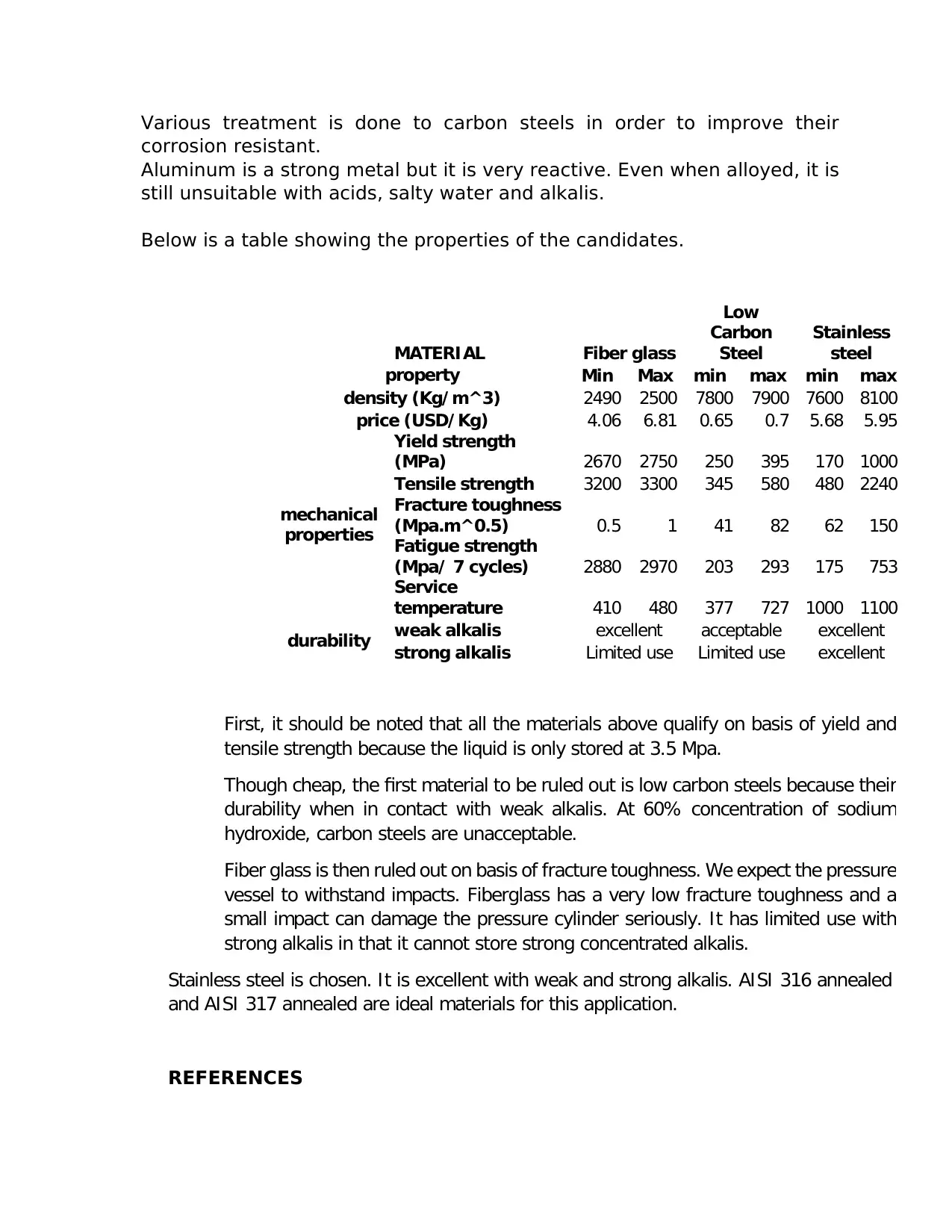
Various treatment is done to carbon steels in order to improve their
corrosion resistant.
Aluminum is a strong metal but it is very reactive. Even when alloyed, it is
still unsuitable with acids, salty water and alkalis.
Below is a table showing the properties of the candidates.
MATERI AL Fiber glass
Low
Carbon
Steel
Stainless
steel
property Min Max min max min max
density (Kg/ m^3) 2490 2500 7800 7900 7600 8100
price (USD/ Kg) 4.06 6.81 0.65 0.7 5.68 5.95
mechanical
properties
Yield strength
(MPa) 2670 2750 250 395 170 1000
Tensile strength 3200 3300 345 580 480 2240
Fracture toughness
(Mpa.m^0.5) 0.5 1 41 82 62 150
Fatigue strength
(Mpa/ 7 cycles) 2880 2970 203 293 175 753
Service
temperature 410 480 377 727 1000 1100
durability weak alkalis excellent acceptable excellent
strong alkalis Limited use Limited use excellent
First, it should be noted that all the materials above qualify on basis of yield and
tensile strength because the liquid is only stored at 3.5 Mpa.
Though cheap, the first material to be ruled out is low carbon steels because their
durability when in contact with weak alkalis. At 60% concentration of sodium
hydroxide, carbon steels are unacceptable.
Fiber glass is then ruled out on basis of fracture toughness. We expect the pressure
vessel to withstand impacts. Fiberglass has a very low fracture toughness and a
small impact can damage the pressure cylinder seriously. It has limited use with
strong alkalis in that it cannot store strong concentrated alkalis.
Stainless steel is chosen. It is excellent with weak and strong alkalis. AISI 316 annealed
and AISI 317 annealed are ideal materials for this application.
REFERENCES
corrosion resistant.
Aluminum is a strong metal but it is very reactive. Even when alloyed, it is
still unsuitable with acids, salty water and alkalis.
Below is a table showing the properties of the candidates.
MATERI AL Fiber glass
Low
Carbon
Steel
Stainless
steel
property Min Max min max min max
density (Kg/ m^3) 2490 2500 7800 7900 7600 8100
price (USD/ Kg) 4.06 6.81 0.65 0.7 5.68 5.95
mechanical
properties
Yield strength
(MPa) 2670 2750 250 395 170 1000
Tensile strength 3200 3300 345 580 480 2240
Fracture toughness
(Mpa.m^0.5) 0.5 1 41 82 62 150
Fatigue strength
(Mpa/ 7 cycles) 2880 2970 203 293 175 753
Service
temperature 410 480 377 727 1000 1100
durability weak alkalis excellent acceptable excellent
strong alkalis Limited use Limited use excellent
First, it should be noted that all the materials above qualify on basis of yield and
tensile strength because the liquid is only stored at 3.5 Mpa.
Though cheap, the first material to be ruled out is low carbon steels because their
durability when in contact with weak alkalis. At 60% concentration of sodium
hydroxide, carbon steels are unacceptable.
Fiber glass is then ruled out on basis of fracture toughness. We expect the pressure
vessel to withstand impacts. Fiberglass has a very low fracture toughness and a
small impact can damage the pressure cylinder seriously. It has limited use with
strong alkalis in that it cannot store strong concentrated alkalis.
Stainless steel is chosen. It is excellent with weak and strong alkalis. AISI 316 annealed
and AISI 317 annealed are ideal materials for this application.
REFERENCES
⊘ This is a preview!⊘
Do you want full access?
Subscribe today to unlock all pages.

Trusted by 1+ million students worldwide
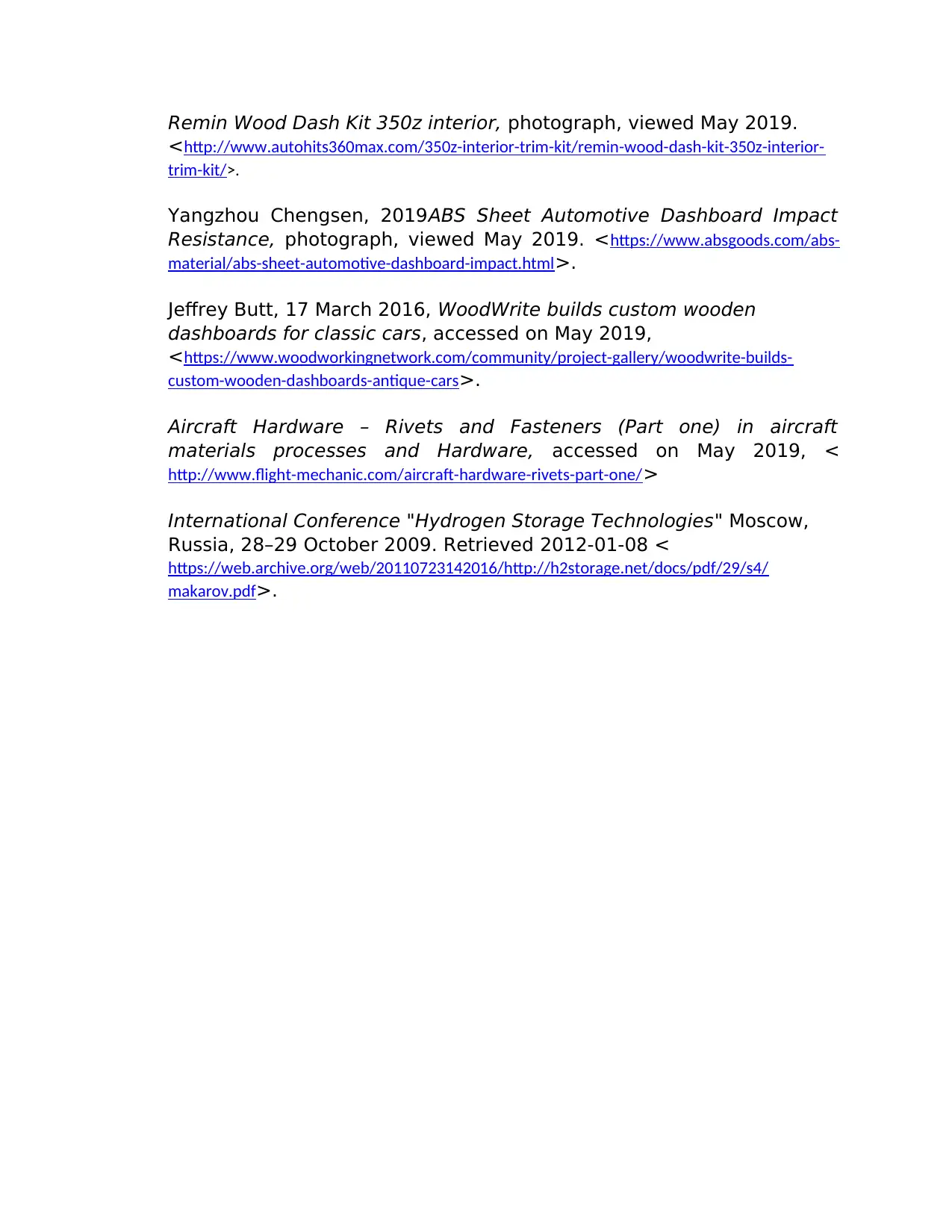
Remin Wood Dash Kit 350z interior, photograph, viewed May 2019.
<http://www.autohits360max.com/350z-interior-trim-kit/remin-wood-dash-kit-350z-interior-
trim-kit/>.
Yangzhou Chengsen, 2019ABS Sheet Automotive Dashboard Impact
Resistance, photograph, viewed May 2019. <https://www.absgoods.com/abs-
material/abs-sheet-automotive-dashboard-impact.html>.
Jeffrey Butt, 17 March 2016, WoodWrite builds custom wooden
dashboards for classic cars, accessed on May 2019,
<https://www.woodworkingnetwork.com/community/project-gallery/woodwrite-builds-
custom-wooden-dashboards-antique-cars>.
Aircraft Hardware – Rivets and Fasteners (Part one) in aircraft
materials processes and Hardware, accessed on May 2019, <
http://www.flight-mechanic.com/aircraft-hardware-rivets-part-one/>
International Conference "Hydrogen Storage Technologies" Moscow,
Russia, 28–29 October 2009. Retrieved 2012-01-08 <
https://web.archive.org/web/20110723142016/http://h2storage.net/docs/pdf/29/s4/
makarov.pdf>.
<http://www.autohits360max.com/350z-interior-trim-kit/remin-wood-dash-kit-350z-interior-
trim-kit/>.
Yangzhou Chengsen, 2019ABS Sheet Automotive Dashboard Impact
Resistance, photograph, viewed May 2019. <https://www.absgoods.com/abs-
material/abs-sheet-automotive-dashboard-impact.html>.
Jeffrey Butt, 17 March 2016, WoodWrite builds custom wooden
dashboards for classic cars, accessed on May 2019,
<https://www.woodworkingnetwork.com/community/project-gallery/woodwrite-builds-
custom-wooden-dashboards-antique-cars>.
Aircraft Hardware – Rivets and Fasteners (Part one) in aircraft
materials processes and Hardware, accessed on May 2019, <
http://www.flight-mechanic.com/aircraft-hardware-rivets-part-one/>
International Conference "Hydrogen Storage Technologies" Moscow,
Russia, 28–29 October 2009. Retrieved 2012-01-08 <
https://web.archive.org/web/20110723142016/http://h2storage.net/docs/pdf/29/s4/
makarov.pdf>.
1 out of 7
Your All-in-One AI-Powered Toolkit for Academic Success.
+13062052269
info@desklib.com
Available 24*7 on WhatsApp / Email
![[object Object]](/_next/static/media/star-bottom.7253800d.svg)
Unlock your academic potential
Copyright © 2020–2025 A2Z Services. All Rights Reserved. Developed and managed by ZUCOL.